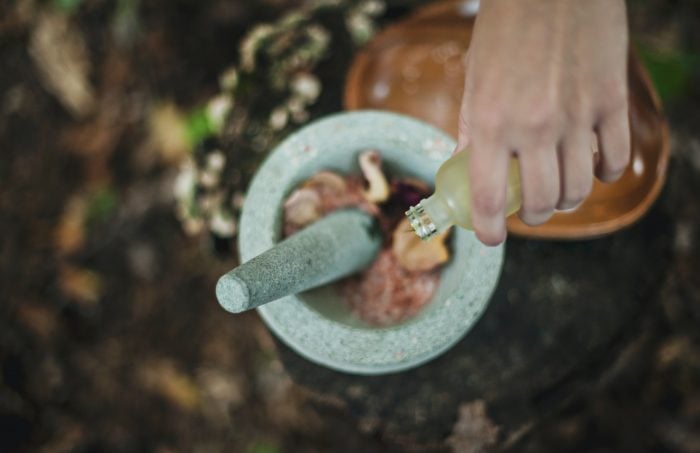*Editor’s Note: Elephant is not your doctor or hospital. Our lawyers would say “this web site is not designed to, and should not be construed to provide medical advice, professional diagnosis, opinion, or treatment to you or any other individual, and is not intended as a substitute for medical or professional care and treatment. Always consult a health professional before trying out new home therapies or changing your diet.” But we can’t afford lawyers, and you knew all that. ~ Ed.
Ayurvedic oils are an essential part of the healing process in Ayurveda, a system of traditional medicine from India that focuses on creating balance for the physical body, senses, psyche, and spirit.
In Ayurveda, oleation in Sanskrit is snehana, which also means “tremendous love and immense tenderness.” The connection here is to self-love practices, offering a warm, loving embrace to our bodies, which also helps support our emotions and psyche.
We must have a healthy body to heal our karma and to live our dharma. Oils are used internally and externally, supporting our dynamic healing journey and overall harmony. The qualities of oil offer balance for the nervous system, digestion, and tissues.
When we observe nature, we see the leaves dry in the fall season, signifying the end of their life cycle. Ayurveda understands that our bodies experience the same cycles as in nature, and that we too can become dry due to our environment, food, lifestyle, mind-body type, and aging. When things dry, they become brittle and crack. Similarly, when our bodies become dry, this affects the integrity of the tissues, elasticity, and functionality.
In Ayurveda, the vata dosha, one of the primary mind-body types, is cold, dry, and light. It governs movement in the body and is connected to the nervous system. One of the core understandings in Ayurveda is that like attracts like and opposites help to balance. The qualities of oil are warm, heavy, and oily. By incorporating the opposite qualities of vata, which is cold, the oil helps provide the body with lubrication, nourishment, and longevity.
There are three mind-body types in Ayurveda: vata, pitta, and kapha, which are paired to create different combinations. These combinations express themselves through a list of qualities and their opposites, both found in nature and within the human experience.
Everyone has their unique mind-body type, or dosha, with specific qualities that influence their body, mind, and spirit. Each oil also has its unique qualities. For example, sesame oil is warmer while coconut oil is more cooling. Besides these base oil, Ayurveda also incorporates herbal oil to address specific imbalances in the body.
When you see an Ayurvedic practitioner, they will recommend some ways to apply oil to different parts of the body, which includes oil in the eyes, nose, mouth, ears, on the skin, or enemas depending on your current imbalance.
One of the most important aspects of applying oil is when it is warm—as warmth opens and invigorates, whereas cold contracts. The warmth allows the oil to penetrate the tissues, move through the channels, and provide healing lubrication to the tissues.
We experience the world through our senses, and with today’s increase in external stimulation, Ayurveda offers us the healing qualities of oil to nourish and relax our senses, and support our overall health and well-being.
“Don’t put anything on your skin that you wouldn’t eat.” ~ Dr. Vasant Lad
Here are a few ways to apply Ayurvedic oil:
1. Oil in the nose (nasya)
The nasal canal is a direct pathway to the brain and consciousness. The oil drops in each nostril help open up the pathways, and support mental clarity and the movement of prana, or energy, and open the sinuses.
2. Oil in the ears (karna)
The ears allow us to hear, but they also offer balance and equilibrium. Ear drops help nourish a deeper balance and calm in the body, as well as the psyche and spirit.
3. Oil in the mouth (oil pulling)
This practice is traditionally done in the morning for oral care, along with tongue scraping. Swishing the oil in the mouth helps remove bacteria, improve dental hygiene, and nourish the gum tissues.
4. Oil on the skin (abhyanga)
This self-massage technique with warm oil is one of Ayurveda’s beloved daily routines. Oil is a natural part of our skin, offering us a protective layer and hydration. By applying warm oil to the skin, it energizes the lymph, blood, and energy in the body. It also benefits the joints, muscles, and skin elasticity, as our skin is our largest organ. Incorporating this ancient practice offers deep nourishment, balance, and longevity to the body.
5. Oil enemas (basti)
The vata dosha mind-body type is connected to the colon. Our natural ways to eliminate toxins are through urine, sweat, and bowel movements. Enemas support the proper and full release of toxins, as well as the natural flow of prana, or energy, that moves down and out. They also help nourish the internal tissues, purify the body, support mental clarity, and calm the nervous system.
Explore the amazing healing benefits of Ayurvedic oil. However, it is important to work with an Ayurvedic practitioner to understand what oil to use, when, where, and how much to apply.











Read 4 comments and reply